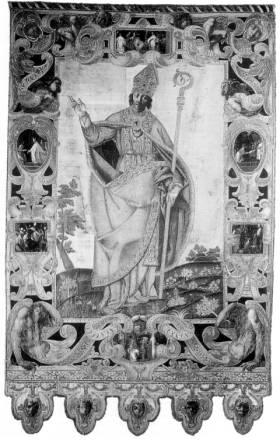
frontside:
standard with the benedicting
Saint Abbondio,
1608-1609, in Como, Cathedral

backside:
standard of Saint Abbondio,
1608-1609, angels adoring the holy Sacrament, in Como,
Cathedral
| ANNE WANNER'S Textiles in History / book reviews, articles |
| Due ricami milanesi
del primo seicento, (two embroideries of Milano
from the early 17th c.), by Marialuisa
Rizzini, in: Il ricamo in Italia dal XVI
al XVIII secolo. (Embroidery in Italy from 16th to 18th
c.), Novara 2001, p. 75-126, in italian language ISBN - 88-8212-241-7, www.interlinea.com |
| The standard of
Saint Abbondio in the cathedral of Como A document preserved from 14th of June 1608 says that the painter P.F. Mazzucchelli, called Morazzone, should present designs for a banner until July 1608. He was commissioned to colour 6 of the small designs which show scenes of Sant' Abbondio's life. The other 6 scenes probably were painted by other persons. A document about payment exist: Morazzone was payed 720 lire, Stella got 5.19 lire, Carerano 17.9 lire and Chiliano 37 lire. About Stella it is known that he came from Veneto, lived in Como in the comune of San Fedele since 1591, he had 2 daughters, and he died in the same place May1st 1614. From September 1608 to June 1609 the banner was also embroidered, there was a close cooperation between embroiderers and painters. A magistro Giovanni Battista Borella from Milano is named. He belonged to the early members of the embroiderers corporation founded in 1583 in Milano. After the year 1609 his name disappears. It seems that he had a professional experience of more than 20 years. |
 frontside: |
backside: |
|
| The vestments for
San Carlo. Already in 1601 the preparations for the canonization of Carlo Borromeo started in Milano. The main celebration was held at the same time in Rom and in Milan on December 7th 1610. Many works of art were created for this occasion but unfortunately most of them are lost today. The vestments can only be retraced by a rich documentation. Among several renowned embroiderers Pompeo Berlusconi was chosen for the gold embroidery and Antonia Pellegrini for figures and coloured silk work. She used a special embroidery stitch, which was invented by Caterina Cantoni and which looked similar on the front and on the backside of the fabric. Cantoni probably died in 1609. Antonia was married to the painter Domenico Pellegrini and her name as a girl was dell' Oro. In 1611 she probably was 28 years old, and her husband at this time 40 years old, they had 2 sons. The cope was finished on 1st of September 1610 and it was presented to the people of Rome in piazza Novara. In the meantime the work for the vestments for Milano had started. Only one new name appears in the list of payments, it is Orlando Scotto. It seems that Antonia Pellegrini was less occupied here. It is only the figure of San Carlo in the center of the altarfrontal, that can be attributed to her for sure. |
detail of
altarfrontal, with San Carlo, 1609-1610, |
|
| home content | Last revised July 27, 2002 | For further information contact Anne Wanner wanner@datacomm.ch |